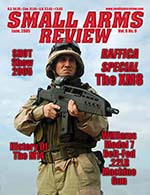By Dan Shea
There have been a lot of questions coming to me from SAR readers who are in the field, about the new Nammo Armor Piercing (AP) ammunition. This ammunition is high performance and it is years ahead of the development of most AP ammunition. I want to disclose up front that I am the General Manager of Defense Munitions LLC, the primary sales company that sells Nammo products (among others) to Federal Operations / US DoE groups in the United States. So my opinion is somewhat biased and I wanted to get that out of the way before we start on taking a "First Look" here in SAR. I don't do puff pieces, and I don't like to shamelessly promote my own products in SAR. I just happen to be the right guy to write this short look at this ammunition. - Dan
Nammo's Small Caliber Division is located in Karlsborg, Sweden. Longtime readers of SAR should be familiar with the general military history of the Swedes from past articles, and several Swedish arms companies have shared their products and historical information with us.
While Nammo's line of Non-Toxic ammunition is a current major environmental safety program for NATO and other countries right now, the flagship of their line has to be their Armor Piercing ammunition. There is nothing else like it on the market, anywhere that this writer has seen. Demonstrations of the Nammo AP compared to other current AP shows the Nammo ammunition having significant penetration above and beyond the other offerings. Nammo claims to have wound ballistic performance with the tungsten carbide projectile core similar to standard ball, after it has penetrated armor. Ballisticians will have to review that; we can only show its performance in armor plate. In the current threat environment, defending or protective forces have to consider they may be facing improvised or factory armor. Scenarios include a vehicle filled with ANFO or other explosive being driven towards an important restricted area, with steel plate having been welded over the vital areas of the vehicle. Soldiers with the standard M240 or M60 machine guns will be unable to stop the vehicle. Using the Nammo AP offering - type classified - in the US with the designation of M993, the chances of stopping this type of attack with those same weapons are much greater. Defeating concrete bunkers or improvised hard cover is much easier with the Nammo AP than any other. At the LMO/DM government firing demonstration in Las Vegas after the SHOT show 2005, Nammo's AP ammunition was fired from one of Dillon Aero's M134D Gatling Guns. The demonstration at 100 meters compared the effects on 1/2-inch steel plate from 7.62x51 ball ammunition to the Nammo M993 7.62x51 AP. The results were so good that many of the various operators and officers who attended have decided to investigate the combination of M134D and Nammo AP as a door gun or Humm-vee mounted gun/ammunition combination for special situations.
The Nammo 7.62 AP projectile needs a speed of 910 m/s to penetrate 18mm of RHA 300HB Steel plate at an angle of up to 60 degrees. This projectile speed is easily achieved from the standard M240 series barrels. It is important for Nammo to test the planned system including correct barrel length and twist rate to ensure the end product combination meets that spec.
The tungsten carbide core weighs 8.3 grams along with its Steel CuZn 10 plated jacket. The phrase "Armor Piercing" or "AP" ammunition covers a lot of different capabilities. The ATFE has definitions of "armor piercing" that are related to what handgun ammunition is suitable for private ownership. These rules and regulations are based on certain percentages of different metals in the projectile. Restrictions are also relevant to handgun use. 7.62x51 NATO cartridges are considered to be handgun cartridges as well as rifle cartridges due to the manufacture of the Remington XP100 handgun that fired this cartridge. Thus, the 7.62x51mm ammunition that meets the armor piercing definitions will be restricted, while ammunition for the 5.56 cartridge is not restricted, as it is not for handguns. Additionally, there are further restrictions imposed on the importation of these types of ammunition, and these are far stricter. Essentially, AP ammunition manufactured in the United States may be bought or sold by non licensees who happen to have it (State and local laws may vary), but manufacture requires a Type 10 Destructive Device license, and the importation requires a Type 11, while simply dealing in this ammunition requires a Type 09 license. There are perhaps fifty qualifying companies in the United States, virtually all of them are government contractors and heavily regulated. No civilian sales are allowed of these types of restricted armor piercing ammunition. Again, Nammo's AP ammunition is not available for private sale. Nammo has a firm policy of restricting access to this ammunition all over the world. They also do not supply ammunition to body armor or vehicle armor testing facilities - only to government agencies.
US Dept of Energy and other Fed Ops users contact:
Defense Munitions LLC
631 N. Stephanie St #371
Henderson, NV 89014
Tel: (702) 566-9811
Fax: (702) 558-1728
Website (Under construction): http://www.defensemunitions.com/
email: defensemun@aol.com
US Dept of Defense contact:
Nammo Inc
2000 N 14th Street, Suite 250
Arlington, VA 22201
Tel: (703) 522-9500
Outside of the US contact:
Attention: Mart Pella
Nammo SCD
Vanasverken AB
PO Box 4 SE-546 23 Karlsborg
Sweden
Tel: +46 505 18100
Fax: +46 505 18155
www.nammo.com
This article first appeared in Small Arms Review V8N9 (June 2005) |
| SUBSCRIBER COMMENT AREA |
Comments have not been generated for this article.







